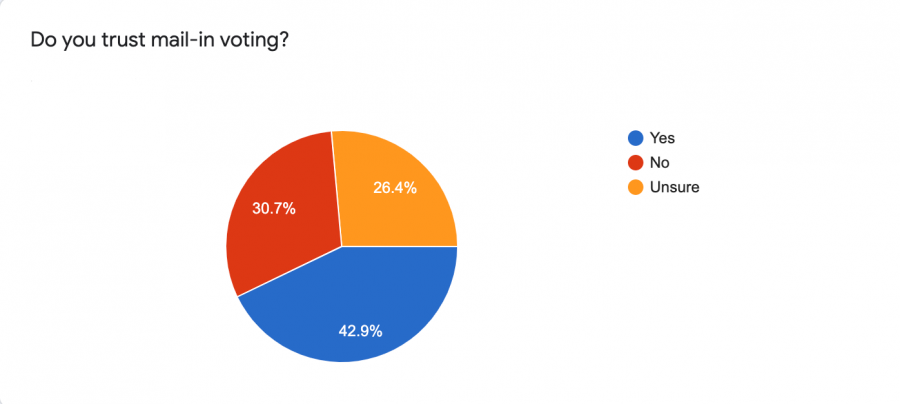Shaker Students Hold Hesitations Towards Mail-in Voting, Poll Reveals
“Im not sure what to trust.”
Less than half of Shaker students do not trust mail-in voting, results from a school-wide poll show. From the 285 respondents, just 43% expressed trust in the absentee voting system, while 31% did not and the remaining 26% were unsure.
From the portion of students who responded with distrust in mail-in voting, a number of individuals provided their own specific takes on why they felt skeptical of the system. These were some of most common reasons for doubt:
- It’s “too easy” for votes to be stolen, changed, or tampered with
- One individual would be able to send in multiple votes
- The mail can get lost or take too long, arriving late
- Once the ballot is sent, its final destinations can’t be seen
However, most of the students from this doubtful group simply defended their position by postulating, or fully claiming, that “fraud,” “rigging,” “sabotage,” and “cheating” permeated the election due to the widespread use of mail-in ballots.
Riddled with could’s, can’s, may’s, and other modal verbs, these baseless yet confident responses illuminate the supporting force behind President Trump’s ongoing claims of election fraud.
Even as the country approaches its tenth week after Election Day, with the Biden-Harris administration just under two weeks away from officially entering office, gigantic street-wide celebrations from excited or relieved individuals (both in the U.S. and abroad), a sizable group of Republican politicians recognizing Biden’s win, and a full victory speech from the Democratic campaign’s team, Trump continues to insist that the election was “stolen” from him, refusing to formally concede.
His Twitter feed, already known for its bombastic tone and contentious claims, is now brimming with fact-checking cautions from the social media platform itself.
“We believe these people are thieves. The big city machines are corrupt. This was a stolen election. Best pollster in Britain wrote this morning that this clearly was a stolen election, that it’s impossible to imagine that Biden outran Obama in some of these states,” he writes in a Twitter post from November 8th.
It is followed with a cautionary message from Twitter: “This claim about election fraud is disputed.”
A retweet from December 6, nearly one month later, shows President Trump maintaining this stance. After a month of flags from Twitter, he captions the retweeted video, “A MUST WATCH! Hope the lawyers are all taking notes. All FACTS, do not flag this Twitter!”
Despite his commanding request, the video, in which an announcer from “Newsmax” presents unfounded statistics supposedly proving Trump to be the election winner, is accompanied by another warning: “This claim about election fraud is disputed.”
Yet, despite the widespread shut-down these social media platforms, news networks, publications, and election experts have placed on Trump’s claims, his Tweets still receive hundreds of thousands of likes, retweets, and comments. Though many have pushed him aside in their celebrations for Biden, his doubt-sowing rhetoric still reaches a wide number of individuals, not only potentially misinforming them, but simply provoking skepticisms in fundamental Democratic institutions as well.
This is reflected in the 86 Shaker students who responded “No” and 74 students who responded “Unsure” when asked if they trusted mail-in voting. These students were not necessarily all supporters of President Trump—many had indicated, in the same poll, that they would vote for Biden. Transcending political alignments, the hesitance to trust mail-in voting (and often the subsequent election results) is a widespread sentiment among youth.
In order to address some of the concerns expressed by students, Ms. Dolan—a Social Studies teacher at the high school—has weighed in with her knowledge as an informed citizen and her experiences as a voter who has voted by mail in the past.
Mail-in voting is a necessity for ensuring every eligible voter’s ability to participate in our democracy, she says. It is a “safe, secure option for those who are physically unable to go to the polls,” including “those who are home-bound due to illness, those who are traveling outside of their voting precinct and college students who wish to vote in their home district.”
Ms. Dolan’s reason for mail-in voting’s importance is echoed by a number of Shaker students who responded that they do trust the system.
“Besides the president claiming that mail-in ballots are fraudulent, it is completely safe in my opinion and helps get people involved in the democratic process,” one student writes.
But what about potential sources of fraud?
To address a few of the common student concerns, Ms. Dolan thoroughly walks through the mail-in voting system, including some of the security measures in place:
“To receive a mail-in ballot, you must request one from your local Board of Elections by filling out an application. After the Board of Elections has confirmed that you are a registered voter by matching the information on your application, including signature, to your voter registration, you will be sent an absentee ballot. Ballots are not sent to every household, or even every registered voter.
Mail-in votes are all paper ballots, which makes them very secure. They are marked by hand and require a signature that can be matched to the original voter-registration card. Paper ballots can also be easily audited after an election to make sure there is no fraud. Most states require both an outer and inner envelope with mail-in ballots, which reduces the chances of tampering. Most states also bar-code these envelopes so that voters can track their ballot through the mail, making sure it was delivered to the election site. If you choose to drop off your ballot in-person, secure drop-boxes that are monitored by election officials are available.
Those who vote by mail are ineligible to vote on Election Day, and if you show up to vote in-person, when you sign in the election worker will know that you have requested a mail-in ballot and will not let you vote in-person unless you turn over the mail-in ballot so it can be destroyed.”
The mail-in voting system is extensive and meticulous to protect the integrity of the election and the country’s democracy.
To any students who still feel skeptical about voting by mail, Ms. Dolan offers a closing piece of advice—continue educating yourself.
Before voting, either in-person or by mail, it is important to educate yourself on the voting procedures in the state, she says.
She recommends all prospective and current voters to “[v]isit the Board of Elections website for your state” with other “additional resources about the security of mail-in voting from reliable sources” to better understand the process.
Ms. Dolan personally suggests perusing the information available from the Brennan Center for Justice at the NYU School of Law, citing that “[t]hey have a great section on the security of mail-in voting.”

(she/her/hers)
Anna Ryu is the Editor-in-Chief of The Shaker Bison. As a senior, this is her fourth year participating in Shaker’s school newspaper....


